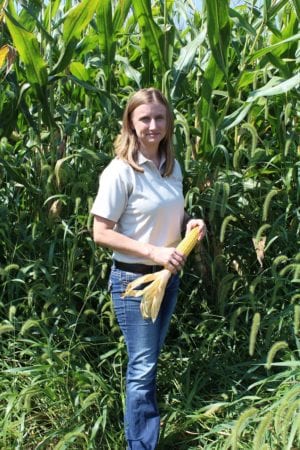Down on the modern American farm, drones and sensors offer a glimpse into the industrial IoT’s applications in the field — literally.
Beyond the reaping and sowing, farming involves lots of checking. For farmers like Emily Buck, who runs 1,000 acres of corn and soybean crops and a flock of 50 ewes in central Ohio, that traditionally meant hours spent meandering through her farm to determine if her crops were malnourished, if they’d been flooded, and so on.

Emily Buck stands in her corn field. Image: U.S. Farmers & Ranchers Alliance
Problems can afflict crops in highly localized way — an infestation in one row may not occur across the entire farm, forcing Buck to travel across her property to take stock of the situation.
That changed this spring when Buck and the hands on her farm used their first drones.
“We had a lot of rain early on and, from the road, one of our fields looked as if it had been drowned and we would need to replant,” she says.
Instead of driving a vehicle out and risking a vehicle stuck in the mud, or trekking by foot, Buck checked the status of her crops aerially with a Phantom 4 Pro drone.
“The video we were able to watch from the drone showed us that the majority of the field had taken the flooding well, and there was no need to replant. A week later and the field had fully bounced back and looks great.”
The Modern Farming Toolkit
Buck is in league with a swell of farmers who are integrating suites of IoT-enabled devices and software to monitor their crops and livestock. Whether by aerial drones or sensors, farming has joined the ranks of industries that are putting the industrial IoT to work. By using technology to remotely monitor products (crops, in Buck’s case), farmers can slash the time spent inspecting their crops and livestock, and measure with near pinpoint accuracy the amount of pesticides and nutrients to apply in the field.
Some farmers use field-based sensors to measure what the human eye can’t see. The small, inexpensive sensors need just enough bandwidth to relay data via the cloud, which means they can be deployed at minimal cost to monitor, say, the nitrogen density of soil or the nutrient richness of a grape by placing sensors on the vine itself.

A Phantom 4 Pro drone. Image: DJI
“There’s really no limit to capabilities of the sensors,” says Michael Orr, a vice president of sales for Sigfox, which creates and deploys low-power networks that connect IoT devices like sensors to each other and to analytics platforms.
But harvesting data is only the first step. Farmers need to understand that data for clues about how to improve their operation. Microsoft, for example, launched FarmBeats to facilitate the use of AI and IoT technology on farms. And Land O’ Lakes partnered with Google to create WinField Data Silo, a cloud storage service for farmers.
The harvest today is still the same as it was for Buck’s forbearers, but the process is anything but.
“Our daily practices have changed quite a bit from when our grandparents ran the farm,” Buck says.


Share this: